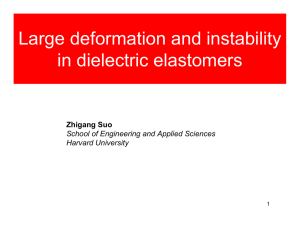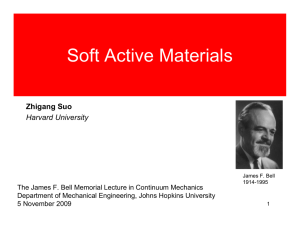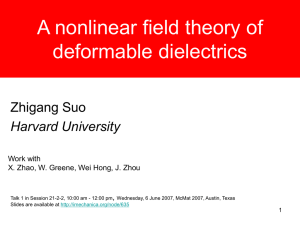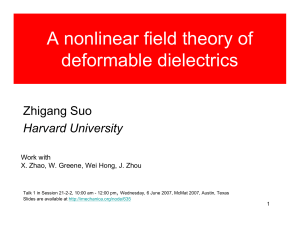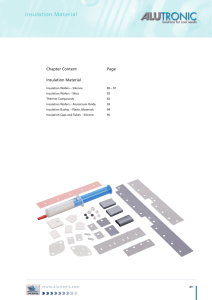Theory of dielectric elastomers Zhigang Suo Harvard University
advertisement
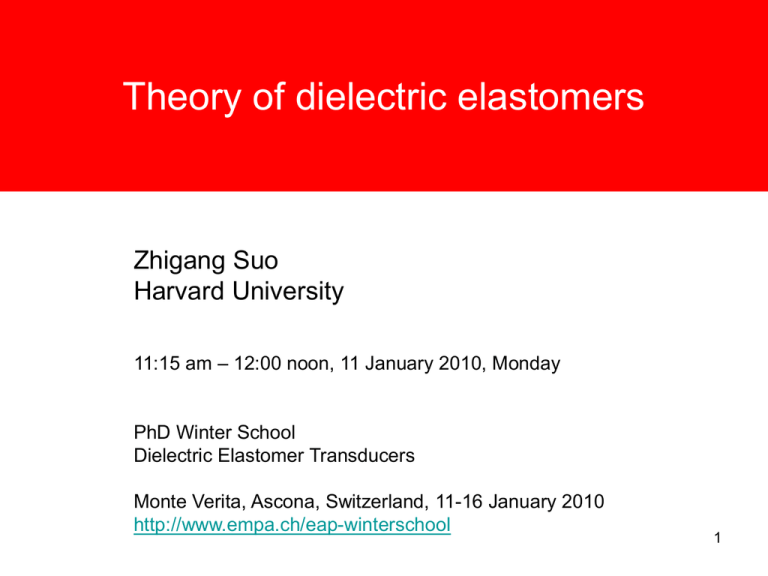
Theory of dielectric elastomers Zhigang Suo Harvard University 11:15 am – 12:00 noon, 11 January 2010, Monday PhD Winter School Dielectric Elastomer Transducers Monte Verita, Ascona, Switzerland, 11-16 January 2010 http://www.empa.ch/eap-winterschool 1 Dielectric elastomer Reference State A Current State Dielectric Elastomer L a l Compliant Electrode Pelrine, Kornbluh, Pei, Joseph High-speed electrically actuated elastomers with strain greater than 100%. Science 287, 836 (2000). Q Q 2 Parallel-plate capacitor P battery a Q electrode l Q vacuum electrode P Electric field Electric displacement field stress field force E l Q D a P a D 0E 0, permittivity of vacuum 1 2 0 E 2 Maxwell stress 3 Trouble with Maxwell stress in dielectrics ----------- +++++++++ Maxwell stress 33 E 2 2 -----------+ - +++++++++ Electrostriction Our complaints: •In general, varies with deformation. •In general, E2 dependence has no special significance. •Wrong sign? 4 An atom in an electric field ------------ p e p e battery Hydrogen atom +++++++++ External electric field displaces positive and negative charges somewhat. •Polarization: Induce more charge on the electrodes. •Deformation: Distort the shape of the electron cloud. 5 A dipole in an electric field ------------ battery Polar molecules +++++++++ External electric field reorients dipoles. •Polarization: Induce more charge on the electrodes. •Deformation: Distort the shape of the sample. 6 Field equations in vacuum, Maxwell (1873) Ei x i Electrostatic field E i q x i 0 Fi qEi A field of forces maintain equilibrium of a field of charges Fi x j Q 0 E E E E 0 j i k k ij 2 P E Q 0 2 E2 ij 0 E j E i Maxwell stress P 0 2 E k E k ij 7 Include Maxwell stress in force balance 1 0E2 2 “Free-body” diagram h gh 1 gh 0 E 2 2 1 2 E 2 8 James Clerk Maxwell (1831-1879) “I have not been able to make the next step, namely, to account by mechanical considerations for these stresses in the dielectric. I therefore leave the theory at this point…” A Treatise on Electricity & Magnetism (1873), Article 111 9 Trouble with electric force in dielectrics In a vacuum, external force is needed to maintain equilibrium of charges +Q +Q P Fi qE i P In a solid dielectric, force between charges is NOT an operational concept +Q +Q Fi qE i 10 The Feynman Lectures on Physics Volume II, p.10-8 (1964) “It is a difficult matter, generally speaking, to make a unique distinction between the electrical forces and mechanical forces due to solid material itself. Fortunately, no one ever really needs to know the answer to the question proposed. He may sometimes want to know how much strain there is going to be in a solid, and that can be worked out. But it is much more complicated than the simple result we got for liquids.” 11 All troubles are gone if we use measurable quantities Current State Reference State A a L l equilibrate elastomer and loads Pl Q AL AL LA name quantities equations of state ~ ~ W s ED ~ W , D s Suo, Zhao, Greene,J. Mech. Phys. Solids 56, 467 (2008) ~ ~ W , D E ~ D Q Q P F Pl Q F divide by volume Nominal W F / AL l/L True s P/A P /a ~ E /L E /l ~ D Q/ A D Q/a 12 Dielectric constant is insensitive to stretch VHB 4910 Kofod, Sommer-Larsen, Kornbluh, Pelrine Journal of Intelligent Material Systems and Structures 14, 787 (2003). 13 Ideal dielectric elastomer Dielectric behavior is liquid-like, unaffected by deformation. ~ D2 W , D Wstretch 2 Elasticity Polarization incompressibility A A 1 a 1 a For an ideal dielectric elastomer, electromechanical coupling is purely a geometric effect: D Q a ~ Q D A ~ D D ~ ~ D 2 2 W , D Wstretch 2 14 Ideal dielectric elastomer ~ ~ D 2 2 W , D Wstretch 2 In terms of nominal quantities ~ W , D s ~2 D dWstretch s d In terms of true quantities ~ D D s D E dWstretch E 2 d 15 Maxwell stress represented in three ways Reference State A Current State Dielectric Elastomer L a l Compliant Electrode Uniaxial stress E 2 biaxial stress E 2 Q Q triaxial stress 1 2 E 2 16 For incompressible material, the 3 states of stress give the same deformation Electrostriction ----------- +++++++++ Maxwell stress 33 E 2 2 -----------+ - +++++++++ Electrostriction 17 Non-ideal dielectric elastomer Dielectric constant 1 c 1 2 3 3 Area ratio deformation affects dielectric constant 18 Wissler, Mazza, Sens. Actuators, A 138, 384 (2007). Quasi-linear dielectric elastomer ~ D2 W , D Wstretch 2 ~ W , D s ~2 dWstretch D d 2 s d 2 d Zhao, Suo, JAP 104, 123530 (2008) 19 The nominal vs. the true Reference State Current State A L Q a l ~ E /L ~ D Q/ A (E / l) ( D Q / a) Q P Nominal electric field and nominal electric displacement are work-conjugate Battery does work ~ ~ ~ ~ Q EL DA AL ED True electric field and true electric displacement are NOT work-conjugate Battery does work Q El Da la ED EDla 20 Extend the theory to general loads 21 Ideal dielectric elastomer Current State Reference State 3 1 2 2 1 1 1 Incompressibility Elastic energy density 3 1 1 2 3 1 23 1 W 1 , 2 Equations of state 1 3 1 W 1 , 2 E 2 1 2 3 2 W 1 , 2 E 2 2 22 Neo-Hookean model 1 23 1 Incompressibility W Elastic energy density W 1 , 2 Equations of state 2 2 1 2 2 1 22 23 3 22 12 22 3 1 3 21 12 22 E 2 2 3 22 12 22 E 2 23 Extend the theory to inhomogeneous field 24 A field of markers: stretch l L Reference state X l L Current state x(X, t) X+dX x(X+dX, t) FiK x i X ,t X K x i X dX,t x i X,t dX K 25 A field of batteries: electric field Reference state L Current state l X x(X, t) ~ E L x(X+dX, t) X+dX X,t X dX,t X dX ,t X ,t dX K ground X ,t ~ EK X K 26 3D inhomogeneous field Condition of equilibrium 2 xi WdV Bi 2 t x i dV Tix i dA qdV dA Need to specify a material model ~ W , D ~ ~ W F, D ~ ~ W F, D siK FiK E K DK Q siK ~ W F, D FiK ~ W F, D ~ EK ~ DK P l 27 PDEs FiK X ,t ~ EK X K x X ,t i X K siK X, t x i X, t Bi X, t X K t 2 2 siK ~ W F, D FiK ~ DK X , t qX , t X K ~ W F, D ~ EK ~ DK Toupin (1956), Eringen (1963), Tiersten (1971), Goulbourne, Mockensturm and Frecker (2005), Dorfmann & Ogden (2005), McMeeking & Landis (2005)… 28 Suo, Zhao, Greene, J. Mech. Phys. Solids 56, 467 (2008) The nominal vs the true Reference State Current State A L Q a l Q P s P/ A P/a ~ E /L E /l ~ D Q/ A D Q/a ij F jK det F siK ~ FiK E i E K Di FiK ~ DK det F 29 Ideal dielectric elastomers Liquid-like dielectric behavior, unaffected by deformation ~ D2 W F, D Ws F 2 Stretch Polarization Ideal electromechanical coupling is purely a geometric effect: Di D i E i ~ ~ W F, D siK F, D FiK ~ ~ ~ W F, D E K F, D ~ DK FiK ~ DK det F ij FiK Ws F 1 E i E j E k E k ij det F F jK 2 30 Zhao, Hong, Suo, Physical Review B 76, 134113 (2007) Finite element method x i X , t X , t Solve for FiK X ,t ~ EK X K x i X ,t X K ~ ~ ~ ˆ W F, E W D K E K Legendre transformation Conditions of thermodynamic equilibrium ˆ 2 xi W i dV Bi 2 FiK X K t i dV Ti i dA ˆ W dV qdV dA ~ E K X K 31 States of equilibrium P B P A L R Simple Layer Zhao and Suo, APL 93, 251902 (2008) Ring Sphere 32 Oscillating Balloon Excitation by sinusoidal voltage Oscillation of the balloon Zhao and Suo, APL 93, 251902 (2008) Zhu, Cai, Suo, http://www.seas.harvard.edu/suo/papers/216.pdf 33 Summary • Ideal dielectric elastomer: dielectric behavior is liquid-like. • Only for ideal dielectric elastomer, the Maxwell stress is valid. • A more general model can represent both the Maxwell stress and electrostriction. • Inhomogeneous, time-dependent field can also be modeled. 34
